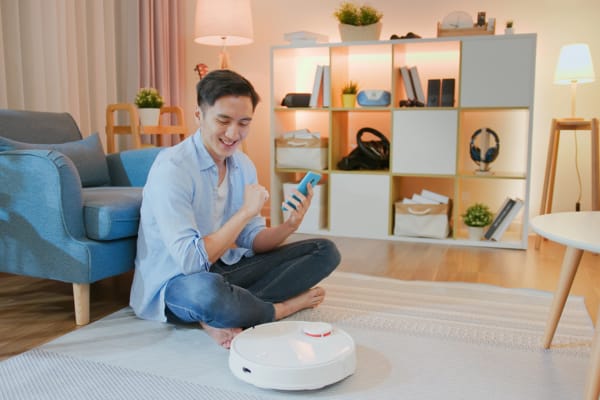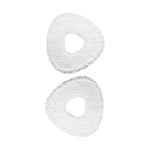Robot vacuums are designed to simplify floor cleaning, but how effective are they really? For most homes, especially those with hard floors or pets, a robot vacuum can maintain daily cleanliness with minimal effort. Their performance depends on how they navigate, how strong their suction is, and how well you use and maintain them.
This guide starts by explaining how robot vacuums work to clean floors using sensors, mapping, and automated suction. We then share practical tips to help you get better cleaning results, followed by a breakdown of the key factors that influence performance, including floor types, room layout, lighting, and upkeep. Finally, you’ll also discover where the technology is headed, from smarter navigation to deeper cleaning capabilities.
Whether you’re comparing models or want to improve the results from your current device, this article offers everything you need to clean smarter, not harder.
How Do Robot Vacuums Work to Clean Floors?
Robot vacuums clean floors using smart navigation, obstacle detection, and suction power to remove dirt and debris with minimal effort. Their cleaning results depend on how well these systems function together and adapt to your home's layout.
Most robot vacuums use cameras or LiDAR sensors to map your home and identify obstacles. This allows them to move efficiently, avoid furniture or cords, and cover more surface area. Advanced models, like the Narwal Freo Z Ultra, combine dual RGB cameras with AI navigation to clean thoroughly without missing corners.
[cta:narwal-freo-z-ultra-robotic-vacuum-and-mop-cleaner-clean-before-you-even-notice]
Suction plays a key role in cleaning performance. While standard models handle dust and pet hair on hard floors, models with adjustable suction can also clean low-pile carpets and detect dirtier areas to boost power automatically. The Freo Z Ultra delivers strong 12,000Pa suction and automatically lifts its mop on carpets to avoid soaking them while maximizing cleaning power.
Another core advantage is automation. You can schedule your robot vacuum to clean during off-hours or while you're away, ensuring consistent cleaning with zero manual effort.
Robot vacuums are effective daily cleaning tools. Understanding how they work helps you choose a model that fits your home and lifestyle for optimal results.
Tips to Improve Your Robot Vacuum's Cleaning Results
To get better cleaning results from your robot vacuum, it’s important to adjust how you use and maintain the device. By following practical tips such as regular maintenance, optimizing cleaning schedules, adjusting suction power, using targeted zones, and increasing cleaning frequency, you can significantly improve daily floor cleaning performance.

Regular Maintenance
Keep the vacuum in top shape by cleaning its brushes, filters, wheels, and sensors regularly. Dirt buildup can reduce suction and navigation accuracy. Make sure the dustbin is emptied often and the battery is charged before each use.
Optimized Cleaning Schedule
Schedule the vacuum to run when you're not at home or during quieter times. This ensures it can clean uninterrupted and cover more ground. Consistent scheduling also prevents dust and debris from accumulating.
Adjust Suction Settings
Many robot vacuums allow you to increase suction power through the app or onboard controls. For rooms with carpets or more foot traffic, use the highest setting to improve dirt pickup. Lower suction can be used on hard floors to save battery.
Use Zone Cleaning or Virtual Walls
Direct your robot to focus on high-traffic areas by setting up cleaning zones or virtual boundaries. These tools help the robot concentrate on the dirtiest spots and avoid less critical areas.
Increase Cleaning Frequency
In busy homes or with pets, increasing how often the robot runs can help keep floors consistently clean. Many devices allow for daily or even twice-daily cleaning with minimal impact on your schedule.
By following these simple steps, you can get better results from your robot vacuum and keep your floors in top condition every day.
Factors Influencing Cleaning Performance
Several factors affect how well a robot vacuum cleans your home. These include your floor type, room layout, device maintenance, lighting conditions, and your expectations.
Floor Type
The type of flooring plays a major role in cleaning performance.
Hard floors such as tile, wood, or laminate are where robot vacuums excel. They can easily pick up dust, crumbs, and pet hair. Low-pile carpets are also manageable for most models. However, thick carpets are more difficult to clean. Lighter models may struggle to pull dirt from deeper fibers due to limited suction and brush depth.
In many Australian homes with hardwood or tile flooring, robot vacuums perform especially well. However, homes with thick wool carpets, which are common in colder regions, may see reduced cleaning effectiveness unless using a high-suction model.
For example, users with hard floors often report strong results, especially in open spaces. Pet owners frequently praise robot vacuums for keeping pet hair under control between deep cleans. On the other hand, people with plush or cluttered rooms may find coverage less consistent.

Room Layout
The layout of your home also affects how efficiently a robot vacuum can work.
In open areas, vacuums move smoothly and cover more space. Tight rooms with furniture or narrow paths may prevent full coverage. Small items like cables and toys can block the vacuum or cause it to miss certain spots.
Regularly clearing the floor helps the robot navigate better. High-end models with advanced navigation systems and object detection, like the Narwal Freo Z Ultra, are more capable in tricky layouts. These features allow them to clean edges, avoid common obstacles, and adapt to different spaces with minimal input.

Lighting and Environment
Lighting and room conditions can also impact cleaning coverage for certain models.
Some robot vacuums rely on visual navigation systems, which may struggle in dark or dimly lit areas such as under beds or in long hallways. In such environments, cleaning may be inconsistent or incomplete. Choosing a model with LiDAR or infrared sensors helps maintain accuracy in all lighting conditions.
To improve results, run the robot vacuum during daylight hours or use ambient lighting in darker spaces. This simple adjustment can increase cleaning consistency, especially for budget-friendly models.
Device Maintenance
Routine upkeep is essential for long-term cleaning performance.
Brushes, filters, and sensors should be cleaned regularly to maintain strong suction and smooth movement. An overloaded dustbin or clogged brushes can reduce effectiveness. Keeping the vacuum charged and the sensors clean ensures consistent results.
Users who neglect maintenance often notice a decline in cleaning quality over time. In contrast, models with self-cleaning systems and auto-emptying bases, like Narwal Freo Z Ultra, reduce the need for frequent manual intervention and maintain strong performance over weeks of use.
User Expectations
A robot vacuum is best for day-to-day upkeep, not for deep or heavy-duty cleaning.
Some users expect a spotless floor after every run, while others use the robot to manage dust and delay manual vacuuming. Understanding what your device can realistically handle helps you use it more effectively and avoid frustration.

What’s Next for Robot Vacuum Cleaning Technology?
As technology continues to improve, robot vacuums are becoming more efficient and smarter.
- Advances in Navigation and Sensors: Expect to see even more precise navigation systems in the future. These will help robot vacuums avoid smaller obstacles and clean harder-to-reach places more effectively.
- Enhanced Cleaning Capabilities: We can expect future models to offer even better performance on carpets, with stronger suction and more effective cleaning heads that can remove deep-seated dirt.
- Smart Integration with Other Devices: In the future, robot vacuums will likely be more integrated with other smart home devices. This could include syncing with your air purifier to ensure both clean your home effectively or even working with smart schedules to ensure your home is always clean at the right times.
Choose a High-Performance Robot Vacuum for Cleaner Floors
Robot vacuums are a reliable solution for maintaining clean floors with minimal effort. They are especially effective in homes with hard flooring, pets, or high foot traffic. While results can vary based on your room layout and floor type, advanced models like those from Narwal deliver powerful suction, intelligent navigation, and hands-free operation that make daily cleaning easy and stress-free.
To get the most value and performance, choose a robot vacuum from a brand trusted by over a million households worldwide. As Australia's top-rated robot vacuum brand, Narwal Australia offers cutting-edge models designed for real homes, real messes, and real convenience. Whether you're looking for a smart cleaning companion or upgrading your routine, explore the latest Narwal robot vacuums to see why we’re the top choice for Australian families.




















































